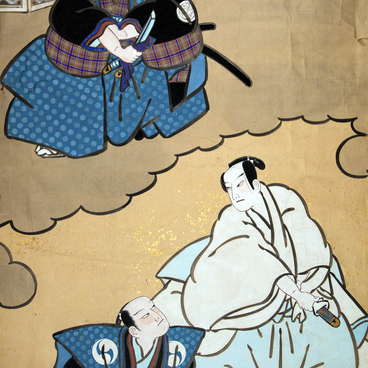In the article ‘An Unexpected Juncture’ (1929), Eisenstein tells how in the play ‘Chûshingura’ (‘47 Ronin’) the acting of the actor moves into the acting of scenery and music in the play: the samurai Yuranosuke leaves the besieged castle; the backdrop with a gate folds twice in the background that is getting increasingly further; a curtain covers up the image of the castle, and sad music comes in - as if the receding sound of the shamisen (a stringed musical instrument). The montage of the stage illusion and music creates the feeling of moving away. Similarly, the newly invented sound film should use sound in a metaphorical counterpoint with the image and taking into account the phenomenon of synesthesia (transfer of auditory sensations to visual ones or vice versa, etc.). Eisenstein was against the continuous dialogue on the screen. It was necessary to use different means of creating images in a single ensemble.
1 / 3
The scene of the hero leaving the castle
Время создания
Japan, 1970s
Техника
Paper, black and white photo printing
Коллекция
Выставка
6
Открыть в приложении#1
Chûshingura. Scene of the hero leaving the castle
#2
#3
Looking at Kabuki, one involuntarily recalls the novel of an American writer, where a person switched the auditory and optic nerves so that he perceived light vibrations as sounds, and the air waves as colors: that is, he began to hear light and see the sounds. The same in Kabuki! We really ‘hear the movement’ and ‘see the sound.’
Here is an example.
Yuranosuke leaves the besieged castle. And he goes from the back of the stage to the front. Suddenly, the backdrop with a full-size gate (a close-up) is folded. The second backdrop appears. It has a smaller gate (a long shot). This means that he has moved even further. Yuranosuke continues his journey. The backdrop is covered with a brown-green-black curtain, that is, the castle has disappeared from Yuranosuke’s view. More steps. Yuranosuke goes out to the “flower road.” The new move is emphasized… by the “samisen, ” that is, by sound!!!
The first move is the steps, that is, the spatial moving away of the actor.
The second move is the two-dimensional painting: changing the backdrop. The third move is an intellectually conditioned sign: “a collective agreement” with a curtain that “erases” the image. The fourth deletion is the sound.
Here is an example.
Yuranosuke leaves the besieged castle. And he goes from the back of the stage to the front. Suddenly, the backdrop with a full-size gate (a close-up) is folded. The second backdrop appears. It has a smaller gate (a long shot). This means that he has moved even further. Yuranosuke continues his journey. The backdrop is covered with a brown-green-black curtain, that is, the castle has disappeared from Yuranosuke’s view. More steps. Yuranosuke goes out to the “flower road.” The new move is emphasized… by the “samisen, ” that is, by sound!!!
The first move is the steps, that is, the spatial moving away of the actor.
The second move is the two-dimensional painting: changing the backdrop. The third move is an intellectually conditioned sign: “a collective agreement” with a curtain that “erases” the image. The fourth deletion is the sound.
Sergey Eisenstein. “An Unexpected Juncture.”
читать дальшескрыть
The scene of the hero leaving the castle
Время создания
Japan, 1970s
Техника
Paper, black and white photo printing
Коллекция
Выставка
6
Открыть в приложении
Поделиться





